Custom SAML applications
You set up and manage your SAML integrations on the Applications tab.
STA includes templates that you use to add and configure a SAML application.
-
Approved templates are based on a review of publicly available documentation, but are untested. Support for approved templates is provided on a best-effort basis.
-
Verified templates are based on lab-testing of the integration and are fully supported. Verified templates are distinguished by the shield
 icon that displays next to them in the template list.
icon that displays next to them in the template list.
Most templates include the configuration options that the service provider requires, as well as application-specific instructions.
If there is no template for your application, use the generic template. For example, you can use the generic template to integrate custom SAML applications. The generic template includes advanced configuration settings to allow you to integrate a broad range of SAML applications.
Configuring an application
After you add an application, you configure it so that your users can access it through STA. First you go to the SAML service provider and configure the SAML application to use STA as the IdP. Then, you configure STA to authenticate the application. Finally, you assign the application to users and groups.
To add a SAML application, complete the following steps:
Select a template
-
On the STA Access Management console, select the Applications tab.

-
Select the Add Application
 icon or click Add Application.
icon or click Add Application.The Add Application dialog box lists all known applications and indicates the application type, such as SAML or agent.

-
Select the Generic Template.
-
To change the application name, edit the name in the Display Name field.
This is the name that is displayed in the list of applications.
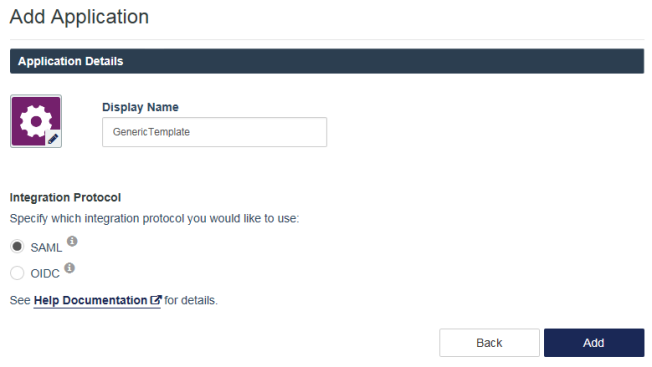
You can replace the system-generated application icon with a custom icon.
-
In the integration type options, select SAML.
-
Select Add.
The application is added in the inactive state.
If this is the first SAML application that you have added, setup instructions are displayed. The instructions explain that the first step is to configure the SAML service provider to use STA as the IdP, and the next step is to configure the application in STA.
Click the next icon, and then click Begin Setup.
icon, and then click Begin Setup.The Configure tab displays the options for configuring the application. You need to configure the application to activate it.
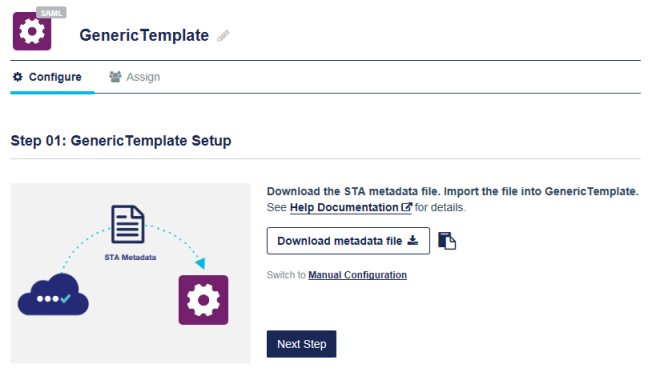
Configure the SAML service provider
You need to provide some information about STA to your SAML service provider, and configure STA as the identity provider for the application. Before you can do that configuration, you need to gather some information from STA that you use to configure the SAML service provider.
STA provides two options for gathering that configuration information:
-
Metadata configuration: Download a metadata file in XML format, and then upload that file for the SAML service provider.
-
Manual configuration: You can manually gather the information from STA, and then use that information to configure the service provider.
When you add an application with the generic template, the Configure tab displays the metadata configuration option, but you can switch to manual configuration.
Configure the SAML service provider using metadata
If the service provider supports it, you can download the metadata file in XML format and then upload that file in the SAML application. Using a metadata file is simpler than configuring an application manually, and avoids typos or copy and paste errors.
If the service provider doesn't support uploading the metadata, see Configure the SAML service provider manually.
-
Click Download metadata file and save the file.
STA saves its metadata file in your Downloads folder. You can later import this file into the SAML service provider (if the SP supports the import option) or use the manual settings.
To configure the application manually, click Switch to Manual Configuration.
-
Go to the service provider's application. Upload the metadata file and complete any additional configuration steps that are required.
-
On the STA Step 01: [application name] Setup screen, click Next Step.
The Step 02: STA Setup screen opens and displays the options for configuring the application in STA.
Configure the SAML service provider manually
-
To configure the application manually, click Switch to Manual Configuration.
-
Use the information on the STA Step 01: [application name] Setup screen to configure the service provider:
-
Copy the ISSUER/ENTITY ID.
-
Copy the SINGLESIGNONSERVICE.
-
Click Download X.509 certificate.
-
-
On the STA Step 01: [application name] Setup screen, click Next Step.
The Step 02: STA Setup screen opens and displays the options for configuring the application in STA.
Configure the application in STA
To configure the application in STA, you need to gather information from the application service provider and enter the information in STA.
By default, when you use the generic template to add an application, the manual configuration options are displayed. However, you can switch to metadata configuration if the there is a metadata (XML) file that you can download from the SAML service provider and then upload in STA. Uploading the metadata file is simpler and faster than manual configuration. However, some service providers don't provide a metadata file.
-
To view the instructions, click the link to display detailed instructions.
The instructions open in a new browser tab, so that you can refer to them while you configure the application.
-
For Manual Configuration, in the Account Details section, enter the ENTITY ID and Assertion Consumer Service URL.
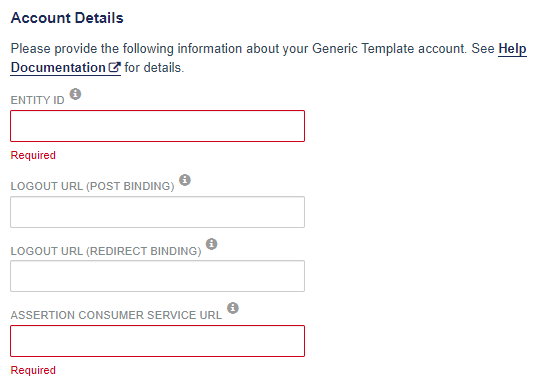
-
In the SAML Certificates section, upload the signing certificate.
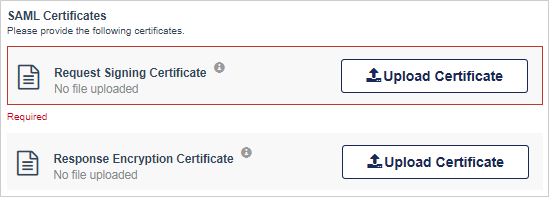
-
In the User Login ID Mapping section, select the attribute to map to the NAME ID parameter.
The STA IdP sends the name ID to the SAML service provider as the user's login ID.
The name ID is part of the SAML assertion, which is the response from the IdP to the application service provider. It contains a Name ID tag, which is the user name to use in the application. It must be mapped to a user attribute in the STA IdP because each application service provider uses different user names. The most common user names are User ID, UPN, and Email address.

-
If the application uses Return Attributes, map each attribute to a Value.
Return attributes authorize the user based on the attribute values.
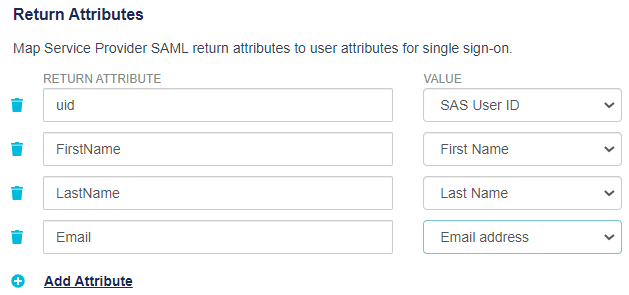
-
To add a return attribute, click Add Attribute. Type the Return Attribute name and select a Value.
If the User Attribute that you need is not in the list, you can add a custom value. Custom attributes can have either a single value or multiple values:
-
Single Custom Value: In the Value list, select Single Custom Value and enter the value.

-
Multiple Custom Values: In the Value list, select Multiple Custom Value. By default, the values apply to all users. However, you can also set the scope of a set of values to specific user groups. A return attribute can have multiple group-scoped sets of values. For example, for the same return attribute, you can have one set of values that applies to groupA and groupB, while another set of values applies to groupC.
-
Enter the custom value.
-
To add another value, select Add Value and enter the value.

-
To include all users from all groups, select All Users.
-
To include a large number of groups, select Groups that: start with, end with, or contain a specific text string. This functionality can be used, for example, to more easily assign roles to the members of multiple groups.
A user may be a member of more than one group. To avoid including unauthorized users, verify that the groups:
• Are authorized to access the resource.
• Contain only users that are authorized to access the resource.As examples, the following are search results for a variety of criteria:
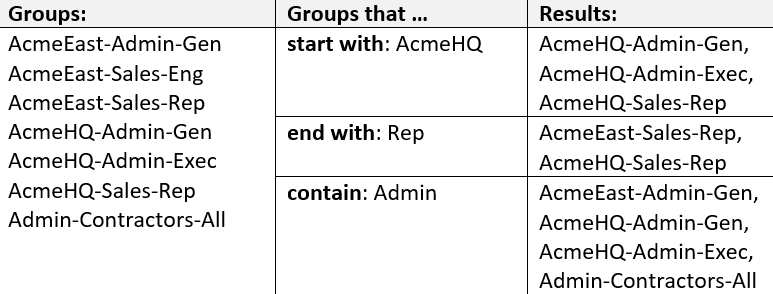
-
To include a small number of groups, select Any of these following groups and then select the groups.
-
To add another set of values, select the menu next to the value, and then select Add New Set.

You can add multiple sets of values, where each set has multiple values.

-
-
-
Configure the User Portal Settings:
Setting Description Options FEDERATION MODE The access request message flow between the SP and the IdP that the system uses when a user initiates access to the application from the User Portal. If the application supports both flows, the system uses the IdP-initiated flow.
- SP initiated
- IDP initiated
SERVICE LOGIN URL The URL that the system uses to access the application when a user initiates access from the User Portal in an SP-initiated flow. This field is available for the generic template and for application templates that do not support the IdP-initiated flow.
-
Configure the Advanced Settings:
Setting Description Options NAME ID FORMAT The format of the NameID element which is mapped to the SP username.
- persistent
- transient
- unspecified (default)
ENFORCE USER NAME The SP can predefine the username displayed on the IdP login page if the username is included in the NameID element of the Subject tag within the authentication request.
- Prompt user to enter a user name (default)
- Use username hint, if available
SIGNATURE ALGORITHM The algorithm used to sign SAML responses. - DSA_SHA1
- RSA_SHA1
- RSA_SHA256 (default)
- RAS_SHA512
AUTHENTICATION REQUEST SIGNATURE VALIDATION SAML AuthN requests are usually signed by the SP. This setting governs whether or not signature validation should be enforced.
The "Verify request signature" option is recommended so as to ensure that STA IdP processes authentication requests from a trusted source only.
- Skip request signature validation
- Verify request signature (default).
A "Request Signing Certificate" must be available to enforce this setting.
ASSERTION ENCRYPTION SAML assertions contained in an IdP response can be encrypted using the Client public key if: i) encryption is supported and ii) an encryption certificate is available.
- Assertion not encrypted (default)
- Encrypt assertion
RESPONSE SIGNING STA IdP can sign the complete response, the assertion contained in the response, or both. Signing the complete response is sufficient but some SPs may require different configurations. - No signature
- Sign assertion and response
- Sign Assertion only
- Sign Response (default)
BINDING PROTOCOL The protocol which is used to submit the IdP response. Post Binding is not restricted in length. The bindings which are available depend on the SP. - Enforce Post Binding
- >Unspecified (default)
GROUP RETURN ATTRIBUTE FORMAT The format of the user assigned group return attribute.
- Comma-separated list
- SAML attribute/value pair (default)
SIGNATURE KEY NAME STA IdP can provide a certificate hint to enable the SP to identify the key used to sign a SAML response. - Certificate Subject
- Key Identifier
- None (default)
IDP INITIATED SSO RELAY STATE The value that the system sends in the SAML assertion response to the SP. This field is available for templates that support the IdP-initiated flow. LOGOUT CHANNEL
When a user logs out of an application in their SSO session, all of the applications in the session are logged out. Choose one of the following channels to implement the logout request:
- Front - to redirect the user's browser to also log out of the SP participating in the SSO session.
- Back - to have the IdP call the SP in the background when the user logs out of the session. This option requires a direct connection between the IdP and the SP; check whether your SP supports this capability.
If in doubt, select Back to ensure that the SSO session is terminated. If the SP does not support back channel logout, or is not reachable by the IdP, this error is ignored.
- Front
- Back
-
Click Save Configuration.
The application is now active and available to be assigned to groups and users.
After you save the application, you can upload new metadata. For some applications, you can also edit the information.
Assign the application to users and groups
You assign an application to users to grant those users with the authorization to access the application. If an application is not assigned to a user, then STA blocks access to the application.
You can assign an application to all users or to specific user groups. An individual user can access the applications that are assigned to all users, or to groups that they are a member of.
If a user is authorized to access an application, the STA authentication flow that is dictated by the applicable policy, scenario, and state of the Single Sign-On (SSO) session applies.
Ensure that users who need access to web applications can use single sign-on (SSO).
-
On the STA Access Management console, select the Applications tab.
-
In the Applications list, select the application.
-
In the application details panel, click the Assign tab.
-
Under Assign to Users, select one of the options:
-
No users (Default)
-
All users
-
Users from any of these user groups: Enter the group names in the text box.
-
-
Click Save Configuration.
An Application Assignment entry is added to the audit log each time an application assignment is saved.

